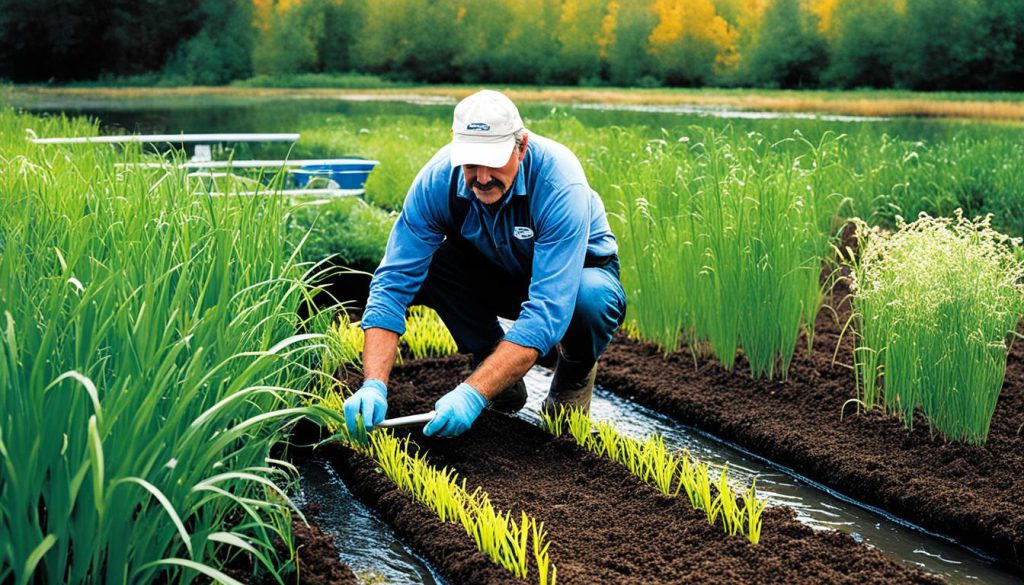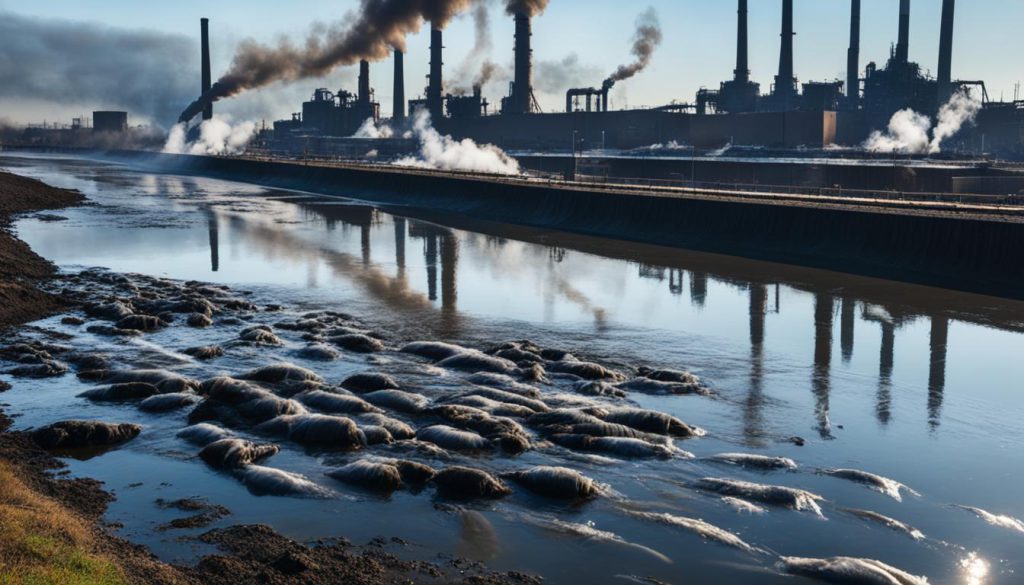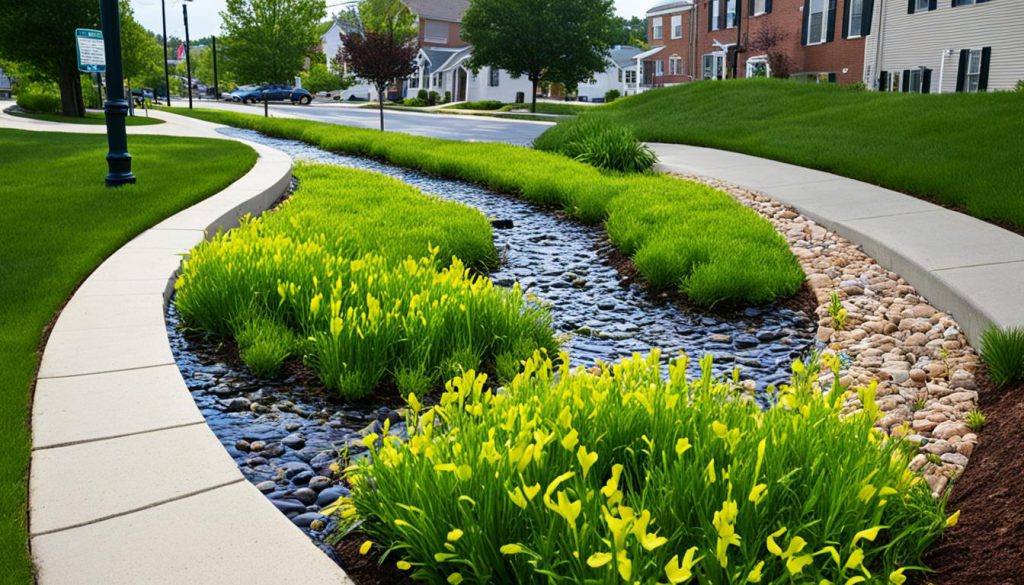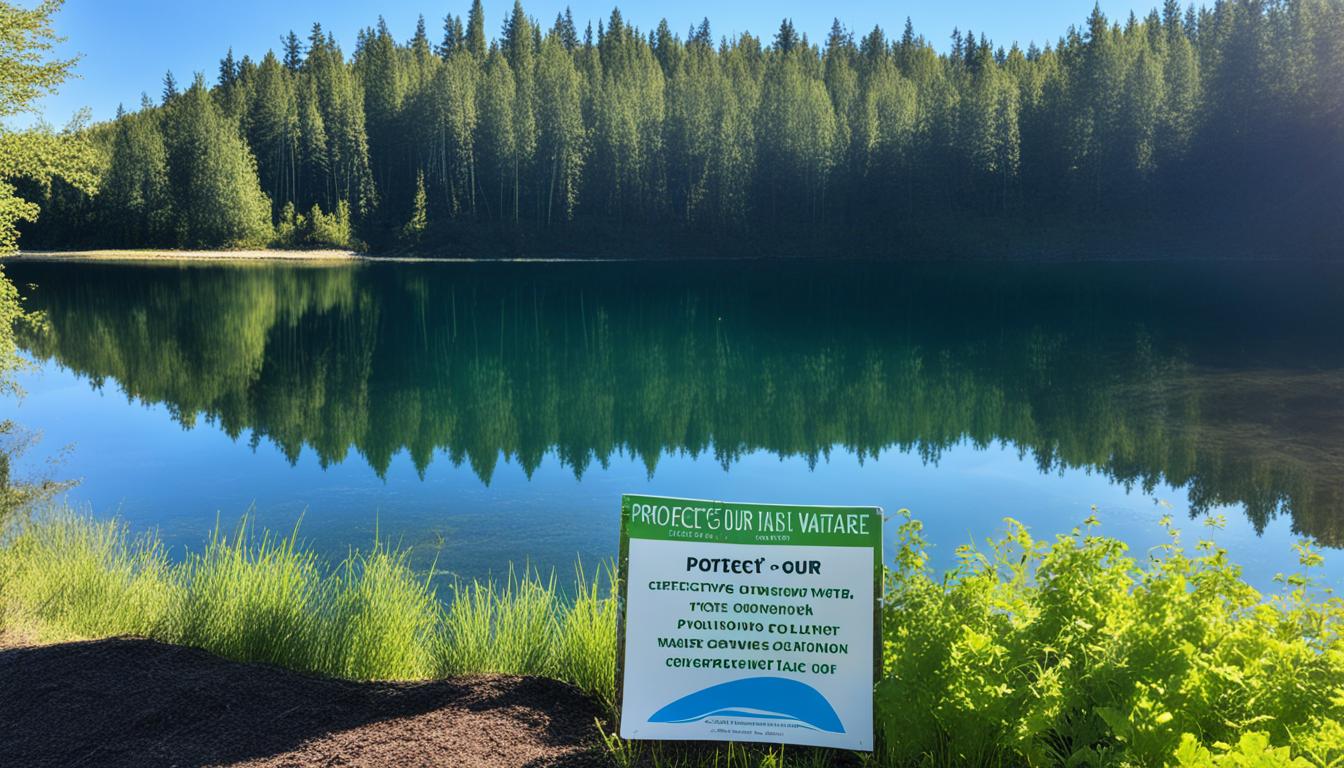Water pollution is a big environmental problem. It threatens human health and the life in our waters. Dirty water can make our drinking water unsafe, hurt sea creatures, and damage the environment. We must fight this issue with strong steps to keep our water clean. Doing this helps us fight pollution and keep water life healthy.
To stop water pollution, we must cut down the sources of pollution and manage it well. Everyone, including people, businesses, and governments, needs to work together. We should use new technologies and green habits. By focusing on different pollution sources, we can really help our water stay clean.
Key Takeaways:
- Water pollution poses risks to human health and aquatic ecosystems.
- Implementing effective strategies for water pollution control is crucial.
- Reducing pollution sources and implementing proper management systems are essential.
- Collaboration between individuals, industries, and governments is necessary.
- Adopting sustainable practices and utilizing innovative technologies is crucial in combating water pollution.
Wastewater Treatment for Water Pollution Control
Wastewater treatment is key in reducing water pollution. It employs a mix of chemical, physical, and biological processes. These processes aim to cleanse wastewater before it returns to nature. This enhances water quality and protects aquatic life.
Advanced technologies have been developed for water clean-up. Chemical methods use coagulants and disinfectants to remove impurities. Physical processes, such as filtration, remove solids and germs. Biological methods use microbes to break down organic matter, further cleaning the water.
At wastewater facilities, various tools and sensors are crucial. For instance, pH and conductivity sensors monitor and adjust water properties. This ensures the treatment is done right. Thanks to these technologies, treatment has become more effective and precise.
Efficient treatment systems cut down water pollution and protect our water. They bring environmental and economic gains like job creation and promote green practices.
“Wastewater treatment facilities are vital in keeping our waters free of pollution. Effective treatments remove pollutants, conserving water quality for the future,” says Dr. Lisa Johnson, a water pollution expert.
Advantages of Wastewater Treatment:
- Reduces harmful pollutant release into waterways
- Shields aquatic ecosystems and wildlife health
- Enhances water quality for drinking and other uses
- Helps prevent waterborne diseases
- Supports sustainable water management efforts
Wastewater treatment is crucial in combating water pollution effectively. With advanced technology and strict rules, we can fight pollution and build a safer environment.
| Advancements in Wastewater Treatment Technologies | Benefits |
|---|---|
| Membrane Filtration Systems | High removal efficiency of contaminants |
| Activated Sludge Process | Effective removal of organic matter |
| UV Disinfection | Eradication of harmful pathogens |
| Biological Nutrient Removal | Reduction of nutrient pollution |
Managing Agricultural Runoff to Prevent Water Pollution
Agricultural runoff is a big problem for water pollution. It happens when pesticides and fertilizers wash into our water. We need good practices to stop this and keep our water clean.
Proper soil care is key to handling agricultural runoff. Practices like contour plowing and using cover crops help a lot. They stop soil from washing away and taking pollutants to our rivers and lakes.
Using water wisely is also important. Efficient irrigation systems help farmers use less water. This means fewer harmful chemicals get into the water below the ground. Tools like soil moisture sensors help use water at the right times, cutting down on runoff.
Organic fertilizers can make a big difference too. They come from natural stuff like compost and manure. They’re better because they feed plants slowly. This means there’s less chance for chemicals to run off into our water.
“Good soil care, smart water use, and organic fertilizers are important. They help us fight pollution from farms. By using these methods, we help our planet and people’s health.”
To make these good farming practices common, we need education and support. Farmers and the farming industry have to work together. Governments and groups can help with incentives and resources. Working together is key to finding new ways to keep our water clean.
Economic Benefits of Agricultural Best Management Practices (BMPs)
On top of helping the environment, good farming practices can save money. They cut down the need for expensive chemicals, make soil healthier, and use water better. This means savings for farmers. Plus, eco-friendly farming can lead to better quality crops that people want to buy.
Case Study: Sustainable Agriculture Initiative
The Sustainable Agriculture Initiative works with many groups to push for greener farming. It offers tools and advice to farmers. This helps them use best practices that lower their impact on the environment and stop pollution. Thanks to the SAI, farmers are making a difference in keeping our waters clean.
Comparison of Agricultural Runoff Management Techniques
| Agricultural Runoff Management Technique | Key Benefits |
|---|---|
| Proper soil management | – Reduces soil erosion and nutrient loss – Improves soil structure and water holding capacity |
| Controlled irrigation | – Minimizes water usage and runoff – Prevents leaching of chemicals into groundwater |
| Use of organic fertilizers | – Releases nutrients slowly, reducing runoff – Improves soil fertility and health |

Regulating Industrial Discharge for Water Pollution Control
Industrial discharge is a major source of water pollution. It sends harmful chemicals into water bodies during industrial activities. To tackle this, strict rules are needed to push for adherence to pollution prevention steps. Factories must use new technologies to prevent pollution and manage waste better. This will lower pollution in our water.
Having effective rules is key to controlling industrial waste and keeping waters clean. Governments and agencies worldwide have set up systems to check on industry’s impact on water. These include rules for treating industrial water, setting discharge limits, and taking action to ensure these rules are followed.
Using technology to cut industrial pollution is vital. Industries can use advanced methods to clean wastewater before it’s released. These methods, like filtering and disinfecting the water, help remove pollutants. With these technologies, companies can better follow the rules and keep our water clean.
Following the rules makes sure industries reduce their impact on water. This effort stops harmful pollutants from harming water life and communities that depend on these waters.
Good waste management is also critical to control industrial waste and water pollution. Factories should reduce dangerous waste creation, encourage recycling, and safely handle wastewater. By adopting these practices, industries protect our water and lessen risks from their operations.
Monitoring and Enforcement
Checking and enforcing rules are crucial to ensure industries follow the guidelines for waste discharge. Agencies inspect and test industrial wastewater to check if industries are meeting standards. When companies don’t comply, they face penalties, highlighting the need to stick to the rules.
To improve monitoring, we can use technologies like real-time water testing and remote sensing. They provide ongoing data, helping to quickly spot and address pollution problems.
The Role of Public Participation
It’s important for the public to get involved in regulating industrial discharge and fighting water pollution. People can help by spreading awareness, pushing for stricter rules, and making industries responsible for their environmental effects. Open discussions create transparency and trust, leading to better water protection efforts.
| Regulatory Measures | Benefits |
|---|---|
| Setting discharge limits and standards | – Ensures industries operate within acceptable pollutant concentration levels – Protects aquatic ecosystems and water resources – Promotes sustainable industrial practices |
| Regular inspections and sampling | – Ensures compliance with regulatory requirements – Identifies non-compliant industries and potential sources of water pollution – Allows for timely corrective actions |
| Penalties and legal consequences for non-compliance | – Deters industries from violating regulatory measures – Holds industries accountable for their environmental impact – Provides an incentive for adopting pollution prevention technologies |

Regulating industrial discharge is key to fighting water pollution. By applying strict rules, promoting rule following, and supporting pollution-cutting technology, we can lessen the harm from industries. This protects our water for the future.
Implementing Stormwater Management to Mitigate Water Pollution
Stormwater runoff greatly adds to water pollution. It carries pollutants from cities to nearby waters. To fight this pollution and keep our waters safe, we must use stormwater management.
These systems use different methods to lessen stormwater runoff’s impact. They help improve water quality.
Retention ponds are one way to manage stormwater. They collect stormwater, filter out pollutants, and then slowly release the water. These ponds prevent too much water flow and pollution from reaching our waters.
Green infrastructure is key for stormwater management. It uses plants, permeable surfaces, and nature to handle stormwater. Rain gardens, green roofs, and bioswales are examples. They absorb rainwater, letting it seep into the ground. This reduces runoff into waters.
Using green infrastructure in cities helps with stormwater impacts. It makes water cleaner and brings environmental perks. It helps air quality, cools cities, and gives us green spaces.

Another method is using permeable surfaces. These surfaces, like porous concrete, let rainwater go into the ground. This lowers stormwater’s amount and speed. It’s a good option where green spaces are scarce.
To manage stormwater, governments, planners, and environmental groups must work together. Their goal is to reduce runoff pollution and protect our waters and aquatic life.
The Benefits of Stormwater Management
Good stormwater management has many benefits:
- It cuts down water pollution by handling stormwater runoff.
- It keeps aquatic ecosystems safe by stopping pollutants from getting into waters.
- It prevents flooding and erosion by managing stormwater.
- It makes water better for fun activities and keeping ecosystems healthy.
- It makes cities more beautiful and livable by adding green spaces.
By using stormwater systems and sustainable ways, we can fight runoff pollution. This protects our water for everyone in the future.
| Stormwater Management Techniques | Key Features |
|---|---|
| Retention Ponds | Temporarily store stormwater runoff and filter out pollutants before release |
| Green Infrastructure | Utilize vegetation and permeable surfaces to capture and absorb rainfall |
| Permeable Surfaces | Allow rainfall to infiltrate the ground, reducing runoff and pollution |
Conclusion – Taking Action for Water Pollution Control
Water pollution control is vital for protecting our environment. It ensures the well-being of humans and aquatic life. Strategies like wastewater treatment and managing agricultural runoff can help.
We need to significantly cut down water pollution to keep our water clean. This includes regulating industrial discharges and managing stormwater better.
Everyone must step up to fight water pollution. This includes people, industries, and governments. By using sustainable practices, we can lessen our impact on waterways.
It’s all about working together to protect the environment. Pollution prevention and sustainable technology are key. Together, we can save aquatic life and keep our water clean for everyone’s future.
Environmental protection is a team effort. We need to understand the importance of preventing pollution. Teaching and spreading awareness can lead to better actions and sustainable habits.
Let’s make a promise to guard our waters by controlling pollution. By acting now, we can secure a healthy water future. This means a thriving ecosystem and a better life for us all.
